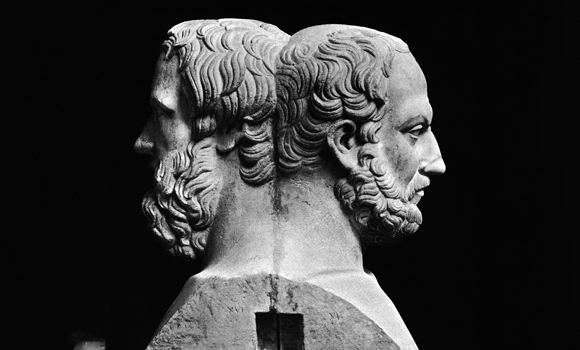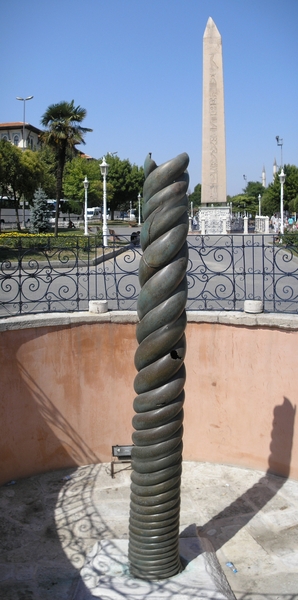C08 |
Inscriptions in Ancient Greek Historiography and in Ancient Greek Novel |
current staff members
| Teilprojektleiter | Prof. Dr. Jonas Grethlein |
| akademische Mitarbeiterin | Christina Schulz |
former staff members
| akademischer Mitarbeiter | Benjamin Allgaier |

Vor allem Althistoriker haben dem Verhältnis der griechischen Historiographie zu Inschriften viel Aufmerksamkeit geschenkt. Man hat die narrativen Darstellungen der griechischen Historiker mit den uns überlieferten epigraphischen Zeugnissen abgeglichen, in Inschriften eingemeißelte Geschichtswerke untersucht und die Frage verfolgt, in wie weit Herodot und seine Nachfolger auf Inschriften als Quellen zurückgegriffen haben. Das hier vorgestellte Projekt soll einen weiteren, bisher noch kaum behandelten Aspekt erforschen, nämlich die meta-historische Signifikanz von Inschriften in der griechischen Geschichtsschreibung. Als ein anderes Medium der Erinnerung bieten sich Inschriften als ein Spiegel für die historiographische Memoria an. Immer wieder bedienen sich die Historiker epigraphischer Semantik, um ihre Geschichtswerke als inschriftengleiche Monumente zu inszenieren. Zugleich dienen in die historiographischen Erzählungen eingebettete Inschriften als mise en abyme und rücken die Überlegenheit des eigenen Mediums ins Licht. Eine Studie der meta-historischen Signifikanz von Inschriften bei den griechischen Historikern wird sowohl ihr Selbstverständnis und ihre narrative Technik als auch die Wahrnehmung von Inschriften in der griechischen Antike neu beleuchten.
Ausführliche Projektschreibung
Bei den für das Projekt C08 einschlägigen Geschichtswerken von Herodot und Thukydides handelt es sich um die frühesten vollständig überlieferten inschriftenbezogene Meta-Texte in griechischer Prosa.
Die eingebürgerte Bezeichnung dieser beiden Texte als ‚Geschichtswerke‘ lässt leicht die Erwartung aufkommen, dass Inschriften bei Herodot und Thukydides als historische Quellen zitiert werden. Vor allem in der Herodot-Forschung stand dementsprechend oft die Frage nach der Zuverlässigkeit der Angaben zu Inschriften im Mittelpunkt. Einer der wenigen Fälle, wo wir einen direkten Zugriff auf ein von Herodot erwähntes schrifttragendes Artefakt haben, ist die sogenannte Schlangensäule. Diese beschriftete Bronzesäule, welche die Griechen laut Herodot in Delphi dem Apoll geweiht haben, kann noch heute – allerdings an einem anderen Ort, nämlich im Hippodrom in Istanbul – betrachtet werden.
 Ein Vergleich zwischen den Angaben in den Historien und unserem Verständnis der Schlangensäulen-Inschrift ergibt eine eigenartige Mischung aus Übereinstimmungen und Diskrepanzen, die in der Forschung sehr unterschiedlich gewichtet worden sind. Beispiele wie die Schlangensäule weisen darauf hin, dass es einen Zusammenhang zwischen inschriftlicher Praxis und historiographischer Darstellung gibt, der sich aber nicht als schlichte Aufzeichnung epigraphischer Daten verstehen lässt.
Ein Vergleich zwischen den Angaben in den Historien und unserem Verständnis der Schlangensäulen-Inschrift ergibt eine eigenartige Mischung aus Übereinstimmungen und Diskrepanzen, die in der Forschung sehr unterschiedlich gewichtet worden sind. Beispiele wie die Schlangensäule weisen darauf hin, dass es einen Zusammenhang zwischen inschriftlicher Praxis und historiographischer Darstellung gibt, der sich aber nicht als schlichte Aufzeichnung epigraphischer Daten verstehen lässt.
Die inschriftliche Dimension der klassischen griechischen Historiographie umfasst ganz verschiedene Aspekte: Einerseits werden bisweilen Informationen, die auf epigraphische Quellen zurückgehen dürften, nicht als solche markiert; andererseits sind manche Angaben Herodots zu bestimmten Inschriften nicht oder nur auf sehr verschlungenen Wegen mit der epigraphischen Realität in Verbindung zu bringen. Ein weiterer bedenkenswerter Aspekt ist die Möglichkeit, dass programmatische Passagen wie etwa das Proöm von Herodots Werk den Vorstellungsbereich von Inschriften evozieren, auch wenn sie keine konkreten Erwähnungen bestimmter Inschriften enthalten.
Während alle bisher genannten Aspekte in der Projektarbeit berücksichtigt werden, liegt der Schwerpunkt auf der genauen Analyse von konkreten Inschriften-Erwähnungen im jeweiligen narrativen Kontext des thukydideischen bzw. herodoteischen Geschichtswerks. Dabei geht es insbesondere um die Frage, inwiefern die in den Erzählfluss integrierten inschriftlichen Texte als Spiegel für das jeweilige Erzählprojekt dienen (d.h. metahistorisches Potential entfalten). So ist es beispielsweise bemerkenswert, dass Herodot, der sein Werk im Proöm als Mittel der Erinnerungsbewahrung ankündigt, davon erzählt, wie ein vom persischen König Dareios mit großem Sendungsbewusstsein aufgestelltes Inschriftenpaar fragmentiert wird. Im Werk des Thukydides lässt sich die interessante Konstellation beobachten, dass eine bestimmte Inschrift zunächst vom Erzähler im Rahmen eines Exkurses in die Zeit vor dem Ausbruch des Peloponnesischen Krieges erwähnt und dann später in einer zitierten Rede von den Sprechern zur Stärkung der Argumentation herangezogen wird.


